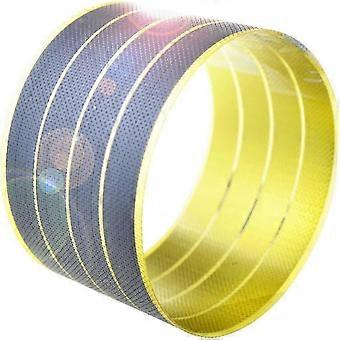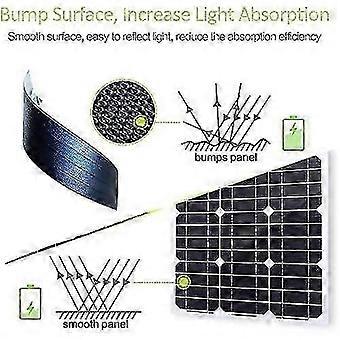الوصف
Operating Voltage: 7.5VOperating Current: 380mA Open circuit voltage: 6VShort circuit current: 350mAPower: 2WUse of the environment: -40 ~ 80 Performance: corrosion, moistureSize: Length 355mm/13.98(plus blackedges 380mm/14.96) X Width 82mm/3.23 (plus black edges 90mm/3.54) X thickness0.5mm/0.02.Weight: 47 g 2 grams. Packaging Material: durable, hightransmittance ETFE film Adhesive: weather, high transmittancefast curing EVA filmBattery Type: Flexible triple junctionamorphous silicon thin film solar cellsNote: The above refers to the electricalperformance parameters measured under standard test conditions, namely: lightintensity 1000W / , spectrumAM1.5, cell temperature 25 .
Flexible solar panel is use special high-end thin film technology.it have a special layered configuration that uses all of the different materials ability to absorb light to their full potential., It is has more advantages than laminated solar panel, such as good performance in the high temperature and in the low light, light weight to be more suitable for buildings which are sensitive in weight. The most important feature of the flexible solar panel is can be flexible or foldable.
This feature can give more space for these panels could be used in applications where conventional solar panels simply wouldn't be appropriateOur rollable and flexible solar panels power innovative solar applications. In case our standard products cannot match a requirement, we offer our development, testing and manufacturing expertise to customize solar panels & films for special applications. Our proprietary laser patterning technology allows us to adapt the shape and electrical output of a module to customer requirements, while our manufacturing process allows us to encapsulate the solar foil in different materials to achieve flexible and rollable form factors.We work on cutting-edge projects with manufacturers of military and emergency supplies, global electrical engineering firms, aerospace industry, automotive industry, as well as innovative product designers.
Range of applications:
Ultra light solar films for aerospaceSolar sails for space applicationsSolar powered dronesSolar for high altitude balloons and airshipsSolar canopiesRollable solar blinds and sunshadesOff-grid and rural electrificationMilitary and emergency powerSolar lighting and signalisationRollable solar consumer productsSolar powered sensors and IoT (Internet of Things)
Solar panels usually get the highest conversion efficiency at 25 degrees C (77 degrees F). However, the temperature of solar module operating in the sun is always higher, especially at the top of a high building. As described in the previous paragraph, crystalline solar panels produce less electricity when the temperature rises above 25 degrees Celsius. But thin film modules are not affected by temperature as much.
the temperature coefficient for the solar cell is 0.2%/degree meaning that whenever the temperature increases by 1 degree, the cells efficiency will decrease by 0.2%. Meanwhile the coefficient of crystalline module is 0.5%/degree. The following table compares the performance of an a-Si rooftop panel to that of a crystalline panel in summer. The temperature is the only variable.
Condition Efficiency of solar panel /%Temperature /degree a-Si thin film 25 (STC) 10358456505ConditionEfficiency of solar panel /%Temperature /degree Crystalline25 (STC) 163511456503.5 As much as 99.9% of the sunlight spectrum is contained in the ultraviolet, visible light and infrared regions. Each PV material has its own preference light range, or part of the spectrum where it converts radiation light into electricity with the greatest efficiency. For example, a cell might convert light with a 500-550 nanometer wavelength (green light) or an 800-1000 nanometer wavelength (infrared light) at a much higher efficiency than the rest of the spectrum. To gain an edge over crystalline solar cells, thin-film cells use multiple physical configurations, meaning they include a variety of layers with whose materials have different preference light ranges.
The more sunlight and spectrum range the solar panel absorbs, the higher its efficiency and output. In cloudy weather, most of the direct visible light, what you call sunshine, is blocked by clouds. However, as the suns rays pass through the atmosphere, small water droplets and other objects scatter visible light, producing diffused light. Therefore, when clouds are not too thick, solar panels still get some visible light because of diffusion. Since infrared light has a longer wavelength than visible light, it can take advantage of diffraction. This effect allows a great amount of infrared light to reach ground. Moreover, there is always some reflected light in the environment. In conclusion,
-
هوية Fruugo:
404567482-858563660
-
EAN:
6917324049919
معلومات سلامة المنتج
يرجى الاطلاع على معلومات سلامة المنتج الخاصة بهذا المنتج الموضحة أدناه
يتم توفير المعلومات التالية من قبل بائع التجزئة المستقل التابع لجهة خارجية الذي يبيع هذا المنتج.
ملصقات سلامة المنتج

تحذيرات السلامة:
Not suitable for children under 3 years. Adult supervision required






